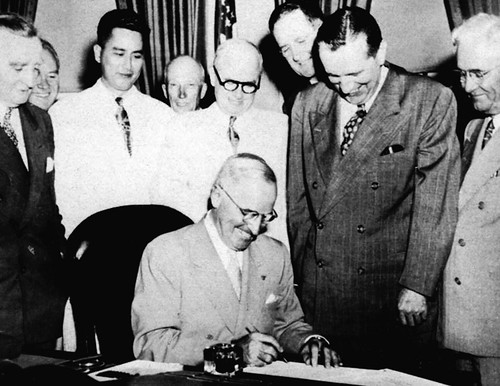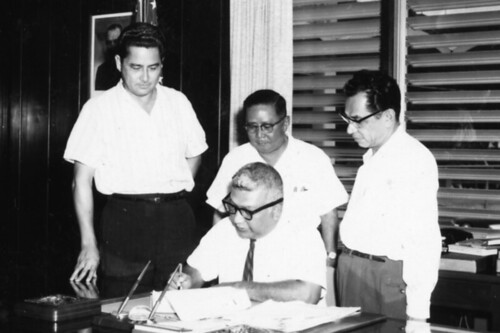Carlos Pangelinan Taitano
Organic Act role
Carlos Pangelinan Taitano (1917 – 2009) was one of the leaders from Guam who brought about the signing of the Organic Act for Guam. He arranged for the crucial media coverage of the Guam Congress Walkout of 1949 that led to CHamorus attaining US citizenship and civil government.
Taitano was also an influential politician during Guam’s first two decades under the Organic Act, as a leader of the Territorial Party of Guam and Speaker of I Mina’ Ocho na Liheslaturan Guåhan/The 8th Guam Legislature. He had a number of careers—as a captain in the US Army, a businessman, a public servant, a civic leader, and was a tireless crusader for the rights of CHamorus.
Walkout
Taitano was a young assemblyman in the Guam Congress in 1949, fresh out of his service with the US Army, when Guam’s long, frustrating quest for US citizenship and a measure of self-government came to a boiling point.
As the Guam Congress discussed the latest in a long line of petitions for US citizenship and a request for an organic act, a controversy arose regarding the power of the Guam Congress to subpoena American citizens.
When the Guam Congress and naval governor Charles A. Pownall engaged in a confrontation over the lack of real power given to the Congress, members of the Guam Congress decided to make an issue of it to bring attention to the citizenship and organic act bills.
Meanwhile, Taitano had met earlier in the year with two visiting journalists from the Associated Press (AP) and United Press International (UPI) bureaus in Honolulu. The two newsmen had agreed to send out reports on the controversy in return for exclusive reports from Taitano.
On 5 March 1949, the members of the Guam Congress, in a fury over strong-arm tactics by Pownall, decided to adjourn until the US Congress acted on the Organic Act for Guam. Taitano, without telling his colleagues, rushed to the telegraph office and sent out a report to Honolulu, and the news was relayed to the world. The New York Times reported “Guam Assembly Quits” on 6 March and “Congress Walkout” on 7 March.
When Pownall called the Congress into a special session, and the members decided not to attend, Taitano’s reports hit the Honolulu Advertiser with the headline, “Guam Congress Revolt Grows.”
The headlines caught the attention of the nation, of the US Congress and of President Harry S. Truman. With members of the US Congress inquiring how the President would handle the situation, Truman decided to end naval rule on Guam, transfer the administration of Guam to the Department of the Interior, and seek the passage of an organic act for Guam.
The Organic Act of Guam was eventually passed, helped by the lobbying efforts of Guam’s leaders as well as stateside sympathizers, and when Truman signed it into law on 1 August 1950, Taitano was the only CHamoru there to watch.
Early years
Taitano was born on 14 March 1917 to Jose San Nicolas Taitano and Dolores Pangelinan Taitano, and was raised on his family’s farm. He persevered through school while helping on the farm, and after high school, was able to leave to Honolulu to pursue a medical education at the University of Hawaii. He graduated with a Bachelor of Science degree in chemistry and took a job as an assistant chemist in the Honolulu Police Department’s criminology division.
Taitano joined the US Army when World War II broke out and served as an infantry officer. He left the Army in 1947 and returned home to Guam as a young military hero. He won a seat in the Guam Congress in 1948. He became an outspoken political leader among more seasoned statesmen, and it was during this first term that he convinced his older colleagues in the Congress to join him in the walkout.
Political peak
In the aftermath of the Guam Congress Walkout and the subsequent signing of the Organic Act, Taitano decided to enroll in law school at Georgetown University in Washington, DC. While there, he founded the Guam Territorial Society, a civic organization of CHamorus and friends of Guam who live in the Washington, DC area.
After graduating with a law degree in 1953, Taitano returned to Guam once again and won a seat in I Mina Tres na Liheslaturan Guåhan/the 3rd Guam Legislature in 1954. Taitano was one of the few candidates in that election who did not run on the Popular Party ticket (it was the only political party on Guam at the time) and ran as an independent—and yet he was the fifth-highest vote getter in the election.
It was during this term in the Legislature that the Popular Party split apart, and eight of the party members joined Taitano and two other independents to elect Francisco B. Leon Guerrero as speaker. The group stayed together and formed the Territorial Party of Guam, and Taitano became one of the new party’s leaders.
During this time, Taitano opened a shop called the Micronesian Village, selling locally produced artwork. In the mid-1960s, Taitano became president and general manager of the Coca-Cola Bottling Company and held this position for six years while still active politically.
The Territorial Party did not win any seats in the Legislature until 1964, when it won a majority of the seats. Taitano was one of the candidates elected, and he was voted in as Speaker of I Mina’ Ocho na Liheslaturan Guåhan/The 8th Guam Legislature.
Taitano was also active as a civic leader, serving as president of the Guam Bar Association and the Rotary Club of Guam and as a board member of the Guam Memorial Hospital and the Guam Chamber of Commerce.
Later years
After retiring from the political arena following his term as Speaker of the Legislature, Taitano continued to be an outspoken leader for CHamoru political rights and a passionate speaker about the CHamoru indigenous culture.
From a young age, Taitano was interested in music, dancing, and the arts (even teaching dance classes while attending the University of Hawaii). In 1964 he wrote, produced, and directed a pageant about the early CHamrous called “I am Chamorri.” The first-of-its-kind, the play was a huge success.
In the mid-1980s he helped organize Guam’s presentation at the Pacific Festival of the Arts, sponsored by the South Pacific Commission; he did the research and inspired the dances and the writing of many of the chants for the production of “Guahu Taotao Tano’.” The storylines were based on Taitano’s research into the movements and chants of the early CHamoru people, and led to the formation of the Taotao Tano’ Dance Troupe.
His geneological interests generated similar interest and research for a number of clans in Guam. He inspired the first Taitano reunion and brought together various family lines linked to a single ancestor going back over 300 years. He re-emphasized the indigenous cultural and geneological roots of the people of Guam.
Taitano continued to study and research CHamoru history, genealogy, and traditions in song and dance until his death on 25 March 2009 at his home in California. He was an outspoken advocate for the civil and political rights of the CHamoru people and addressed the US Congress on this issue in 1998. He died at the age of 92 in 2009.
For further reading
Hattori, Anne Perez. “Righting Civil Wrongs: The Guam Congress Walkout of 1949.” ISLA: A Journal of Micronesian Studies 3, no. 1 (Rainy Season 1995): 1-27.
Hinasso’; Tinige’ Put Chamorro (Insights: The Chamorro Perspective). The Hale’-ta Series. Hagåtña: Political Status Education Coordination Commission, 1993.
Honolulu Advertiser. “Guam Congress Revolt Grows.” 11 March 1949.
Honolulu Star-Bulletin. “Admiral Steps Into Guam’s New Fight Over Naval Rule.” 11 March 1949.
I Manfåyi: Who’s Who in Chamorro History. Vol. 1. The Hale’-ta Series. Hagåtña: Political Status Education and Coordinating Commission, 1995.



